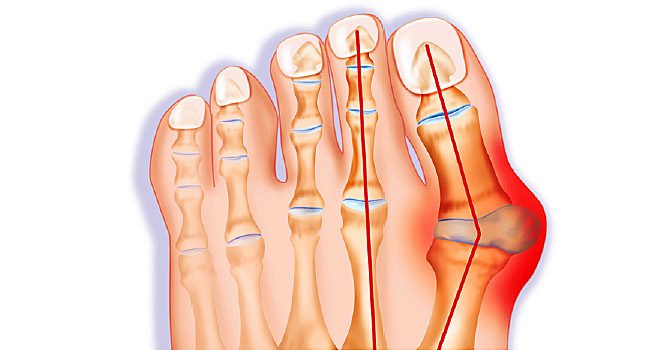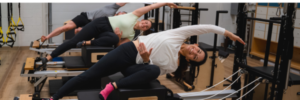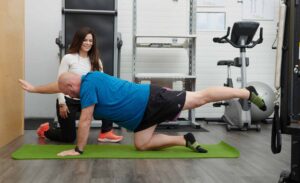Have you started to notice a bony bump along the inside of your big toe or might even be thinking “My feet are starting to look like my grandma’s”? It might just be the start of a Bunion.
What are Bunions?
Bunions, put simply, are a bony enlargement of the big toe. They can be the entire joint or (most commonly) occur only on the inside area. Bunions are often presented alongside ‘Hallux Valgus’, which is when the big toe starts to angle towards the second toe.
Fun Fact: A Bunionette (or Tailor’s Bunion) is a bunion on the outside of the baby toe.
Our big toe plays an important role when we walk, it helps not only with stabilization of the foot but also in the ‘toe-off’ phase of our walk. If either of these functions are not able to happen due to an instability, weakness, or limitation of some kind, other motions may be occurring in the foot that begin to cause more pressure at the big toe joint. This build up in pressure can cause the bones in our big toe to rub together, eventually causing a bony growth to form, or better yet, a Bunion.
How do you develop a Bunion?
Bunions can happen to anyone at any age, though most patients who present with bunions are women. Why? Past literature has blamed this trend on poor fitting, high heeled shoes (David-West, 2011). But that isn’t the only way you can develop a bunion, other factors that have shown to contribute include: genetics, excessive pronation or other uncorrected foot mechanics, previous injury, arthritis or weakened foot muscles. Of these, the main contributing factor for predetermining hallux valgus and bunions is poor biomechanics of the big toe (Clinic Practice Guidelines, 2012).

What can I do to prevent getting Bunions and/or stop them from getting worse?
While some people will (unfortunately) be fortunate enough to ‘win’ the genetic lottery of being pre-disposed to developing Bunions. there are fortunately a number of things we can do to help prevent ourselves from getting them and/or stop them from getting worse.
Take a look at the footwear we are wearing:
Finding the Proper Fit:
- As previously mentioned, poor fitting footwear can contribute to developing Bunions. The foot can become painful because the bunion becomes inflamed from shoe irritation. Finding shoes that come in wide width is key and making sure to have your footwear professionally fitted for your feet. If you are shopping on your own, you’ll want to look for shoes that have a round or square toe box that can accommodate the natural shape of your foot.
Try this out: Take one of your shoes, remove the liner, place your foot on top and stand on it. Your whole foot should be able to sit within the borders of this insole. If your forefoot splays significantly over the sides, this shoe is part of the issue!|
What features to look for in a shoe:
- No seams over the bunion – to prevent further irritation, look for shoes with a soft upper or stretch material.
- Rocker sole – to reduce the pressure under the forefoot and redistribute plantar pressures during gait. A great example of this would be the Brooks Adrenaline with its GuideRail, holistic support, system to provide a smooth stride and relieve pressure og the big toe joint.
- Extra Depth – to allow for the appropriate depth
- Extra Width – You want to look for shoes that come in various widths (Ex, D, 2E, 4E etc). A common mistake is purchasing a shoe that is a size or two longer to accommodate the width of the foot. This, however, is not ideal as it causes the flex point in the shoe to incorrectly match the positioning of the ball of your foot. The Dansko Paisley is a great option that comes in multiple width options, has a stiff forefoot rocker and great arch support!
Shop our great selection of shoes for bunions by clicking here!
Finding a little more support with an over-the-counter or custom foot orthotic
- Orthotics can be helpful to control the underlying poor biomechanics of the foot, like overpronation, to reduce the pain symptoms or slow down the progression of hallux valgus.
- Orthotics can also be used post bunion surgery to control biomechanical abnormalities that would have caused the bunions in the first place. It is unfortunately very common for patients to have surgery only to have the bunion return in the future as their biomechanics were a main contributor.
- Consider booking an appointment with a Certified Pedorthist to determine whether an orthotic would be appropriate for you!
Book an appointment with a Certified Pedorthist to help you Move Well, Be Well.
Find pain relief with a toe spacer/separates and/or Bunion protectors:
- Over-the-Counter silicon (or custom) toe spacer options allow for the big toe and second toe to separate therefore improving alignment and prevent the Bunion from getting worse.
- Bunion Protectors provide a soft protective silicon layer to decrease friction and irritation between the bunion and the shoe.
- Bunion splints or braces can also be a great tool to use to stop the bunion from getting worse and help keep your toe in proper alignment.
Shop all toe spacers, bunion protectors, and braces!
While bunions are nothing to be scared about, they also aren’t something we wish to ever have or want to get worse, fortunately there are many ways we prevent developing bunions and/or stop them from getting worse. If you (or someone you know) has bunions that are causing them pain or don’t know where to start, we recommend always talking to a Certified Pedorthist to help you Move Well, Be Well.
Written in collaboration by Kaleigh Hole (C. PED (C)) and Shayla McLean (B.H.K)




